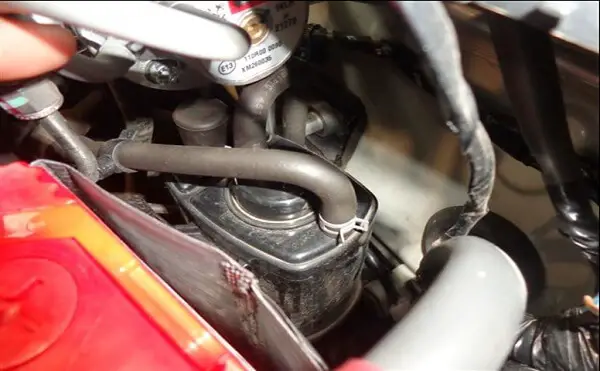Most automobile enthusiasts must have come across the usage of the term evaporative emission control system (EVAP) in the car and other gasoline vehicles.
The Gasoline fuel which one fills in gas vehicles is nothing but a set of various hydrocarbons which are highly volatile and are always ready to evaporate even at low temperatures.
You might have observed that when a small amount of gasoline is kept open to the atmosphere for some time, it disappears and it is because of the evaporation of gasoline vapors.
If these gasoline vapors are not stored and used, then they would escape to the outside atmosphere, creating air pollution and loss of fuel economy.
Hence OEMs use an evaporative emission control system EVAP which mainly consists of a charcoal canister, an evap purge control valve, and other valves to store and control the gasoline vapors that are generated in a fuel tank.
But often people face vehicle-related problems due to bad charcoal canisters and think of deleting the charcoal canister.
Can you bypass charcoal canister? The short answer is yes, but unless you do it properly you will face issues like fuel tank collapse or leak, less fuel economy, engine misfire, backpressure while filling, CEL (Check Engine Light) on dash, tailpipe emission failure or other regulatory issues depending upon the model of your car. It is recommended to replace the bad charcoal canister with a new one instead of bypassing charcoal canister.
If you have the same doubt and looking for technical know-how, then here in this article we will discuss in detail about the same and you will get some inference on the topic.
Table Of Contents
How Do Evap System Work?
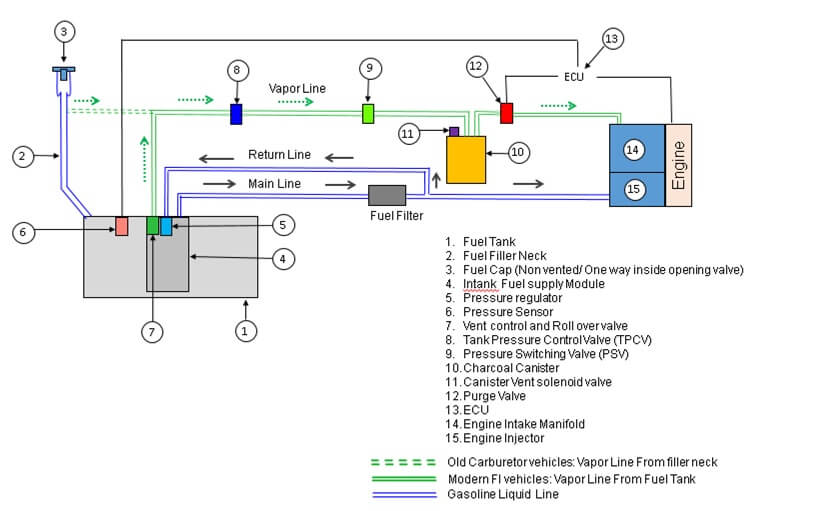
It is essential to use an evaporative emission control system to control and store the gasoline vapors generate in the fuel tank and get consumed in the engine whenever the EVAP system permits.
EVAP system consists of various parts which are fitted in some sequence starting from fuel tank with vent control valve and pressure sensor, pressure control valve, pressure switching/bypass solenoid valve, charcoal canister, vent solenoid valve, purge control valve.
Depending upon the manufacturer and year of manufacturing, one or more valves may not be present in the EVAP system.
A vapor hose connects the gasoline tank to the charcoal canister via. tank pressure control valve (TPCV) and pressure switching or bypass solenoid valve.
One vacuum hose connects the charcoal canister to the engine air intake manifold via. Purge control valve, which is controlled by an electronic control unit (ECU).
Air is present inside fuel tank headspace volume in general. During normal vehicle operation, this air along with fuel vapors that are generated inside the tank due to atmospheric temperature increase are vented to a charcoal canister through a pressure switching solenoid valve.
The charcoal canister adsorbs and stores these fuel vapors on its charcoal particles and releases just hydrocarbon-free air to the atmosphere through the ‘AIR’ nozzle of the canister.
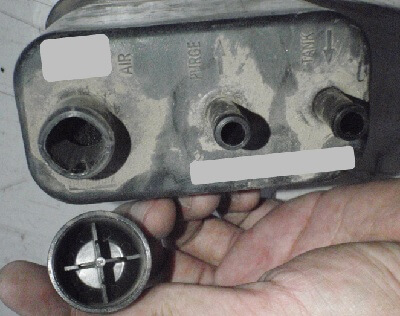
A charcoal Canister usually has three nozzles. The nozzle which is connected to the fuel tank is usually marked ‘TANK’ and the nozzle connected to the purge valve is marked ‘PURGE’.
The nozzle which is marked ‘AIR’ or ‘VENT’ is directly left open to the atmosphere or connected to the atmosphere through a vent solenoid valve.
This nozzle in most of the canisters would be at the canister bottom but not necessarily so depending upon canister design.
The vent solenoid valve sometimes sits on the top of the canister. In some cases, it is mounted on the body frame but connected to the ‘AIR’ port of the canister by a hose.
The other end of the vent solenoid is connected to a hose whose free end is left open to the atmosphere.
Evap purge control valve is normally closed and gets feedback from ECU to open the path connecting the charcoal canister to the engine air intake manifold so that the engine suction vacuum purges and pulls the stored vapors from the canister to the engine.
ECU will signal the evap purge valve to open only under certain conditions which is beneficial for engine operation.
These conditions are predefined when deciding the purging strategy by vehicle manufacturers, so as not to affect the vehicle’s performance and emissions.
What Causes A Charcoal Canister To Go Bad?
Normally the charcoal canister lasts for the life of the vehicle but over some period it may underperform due to the following reasons,
Reduced porosity of charcoal particles
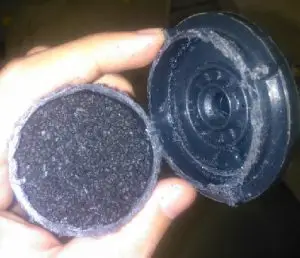
The Canister consists of activated charcoal particles with infinite pores. These pores repeatedly adsorb & release gasoline vapor depending upon the loading of vapors from the fuel tank and unloading vapors during purging.
But sometimes these pores over some time due to vehicle vibrations get crushed and lose their porosity thereby changing into a fine powder.
Many times it happens due to the entry of liquid fuel accidentally into a charcoal canister or through condensation of gasoline vapors before it reaches the charcoal canister.
The condensed vapors turn into liquid fuel and when it reaches the charcoal canister it damages the charcoal’s porous structure thereby making it a fine powder.
The charcoal canister gets filled with gas and goes bad and this fine powder would end up clogging the venting provision of the fuel system.
This leads to an increase of pressure or vacuum in the tank as if we have plugged the vapor hose end of the charcoal canister.
Some canisters have a liquid trap that prevents the entry of liquid fuel into them.
The function of a charcoal canister in storing gasoline vapors also gets hampered. It no more does its operation efficiently.
If the charcoal canister is partially gone bad, it releases most vapors directly into the atmosphere and leads to all issues as explained earlier.
Deteriorated charcoal canister filters
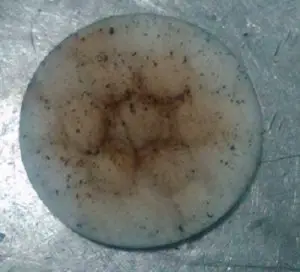
Even though the charcoal canister has filters at both entry and exit ends, sometimes these filters get deteriorated over a while and release charcoal powder to evap purge control valve downstream during purging operation.
This powder gets entangled at the valve seats of the purge valve or damages it. This leads to valve leaks of the purge valve and the associated problems. you may need to clean the evap purge valve if it gets clogged with charcoal powder.
In that, you may need to replace the evap purge control valve with a new one to ensure its proper functioning.
You may also notice charcoal particles reaching the fuel injector nozzles and clogging them up.
Cracked Charcoal canister outer body
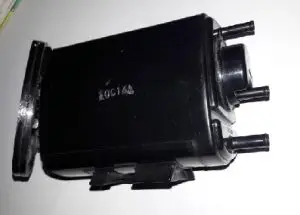
The charcoal canisters are mounted to the vehicle body framework through a suitable bracket design.
Due to the effect of vibration and environmental temperature variations, and harsh weather, the outer plastic body may get cracked and releases the charcoal particles and vapors into the outside environment and would fail the EVAP vacuum integrity test.
Charcoal canister outlet nozzles clogged
Very often the charcoal particles & canister outlet nozzles which interact with the atmosphere get blocked due to the accumulation of mud or dust. Ensure the ends of the nozzles are clear to make way for the exchange of gases.
Can You Bypass Charcoal Canister?
People sometimes experience vehicle-related problems due to bad evap charcoal canisters and think of deleting charcoal canister.
There are many reasons you would like to bypass or remove Charcoal Canister from the EVAP system, for example,
1) You notice a fuel smell coming from the vehicle due to a bad charcoal canister leaking gasoline vapors.
2) While replacing the cracked or worn-out vapor and vacuum hoses of the EVAP system you accidentally break down the nozzles of the charcoal canister and now want to get rid of the same.
3) The charcoal canister gets clogged up, leading to fuel system vent blocking resulting in tank pressure and vacuum build-up.
4) Charcoal canister particles are getting sucked into purge valve & fuel injectors and damage them.
When people talk about bypassing charcoal canister, you can derive 3 meanings from it.
One method of bypassing charcoal canister would be to connect the vapor hose directly from the fuel tank to the purge control valve without connecting it through the charcoal canister and vent solenoid valve connected to it.
The second method to bypass charcoal canister would be to simply plug the charcoal canister end of the vapor hose which is connected to the fuel tank thereby isolating the EVAP emission control system from the vehicle.
The third way to bypass charcoal canister can be by leaving the vapor hose open to the atmosphere which otherwise use to be connected to the charcoal canister nozzle.
We will discuss the probable effects of all scenarios in detail.
Connecting Vapor Hose Directly From Fuel Tank To Evap Purge Valve
Step 1
In this first method to bypass charcoal canister, you remove the vapor hose clamps and connections of charcoal canister attached to ‘AIR’ and ‘PURGE’ ports. Some canisters have quick fix connectors, you need to simply press the connectors on the sides to disengage the connectors.
Step 2
Next, you connect the vapor hose line coming from the fuel tank directly to the evap purge valve, the engine purge vacuum will be directly applied to the fuel tank. But this may lead to the below issues depending on the system design and vehicle model year.
1) Engine tailpipe emission failure
The gasoline liquid and vapor equilibrium in the fuel tank gets disturbed and pressure inside the tank decreases and vapor does not reach its vapor pressure inside the tank.
This leads to more and more evaporation of the gasoline to reach its vapor pressure These unmetered vapors get pulled into the engine air intake manifold.
It leads to disturbance of stoichiometric air-fuel ratio of the mixture getting burnt in the engine combustion chamber when the purge control valve is signaled to open by the vehicle ECU (Electronic Control Unit) for purging.
The fuel proportion is more towards the rich side and results in unburnt fuel (COx and NOx) exiting the engine tailpipe thereby would fail the engine emission test.
2) Check Engine Light (CEL)
ECU checks the integrity of the EVAP system circuit for vapor leaks by performing a series of leaking, venting, and purging test by activating different EVAP system valves in a certain sequence for fixed intervals.
In the absence of a charcoal canister and vent solenoid valve, atmospheric pressure will not get applied to the EVAP system, so ECU through tank pressure sensor will not detect the required vacuum decay while performing the integrity tests.
Hence the vehicle will not pass necessary tests and thereby illuminates check engine light MIL on your dashboard.
Need to ensure that CEL is not triggered by other issues in the engine by checking the DTC trouble codes.
This would be critical depending upon the emission regulations or mandatory SMOG test in your region.
3) Collapsed fuel tank
Usually, the evap purge valve is closed until it is activated by signals from ECU.
But during vehicle running, when the operating conditions are favorable, the purge valve opens and the engine vacuum is directly applied to the fuel tank since the charcoal canister is bypassed.
Due to engine vacuum, the fuel tank would collapse based on vacuum strength. You may notice that the fuel tank is imploded and squeezed at some weak local areas.
4) Less fuel economy
As explained earlier, since gasoline in the tank is highly volatile, when the engine vacuum gets applied to the fuel tank during the purging operation, the evaporation rate of fuel increases, and a good amount of vapors travels to the intake manifold continuously.
Since the vapors are getting generated, the amount of liquid fuel remaining inside the tank will keep on reducing which otherwise would have been used optimally.
This leads to improper fuel consumption and less fuel economy.
5) Engine misfire
If you bypass the charcoal canister, unmetered fuel vapors get continuously pulled into the engine combustion chamber and affect the stoichiometric air-fuel ratio.
This leads to engine misfire and the vehicle would start to rev up uncontrollably even though you are not accelerating and leads to shaky vehicle operation.
You may notice that the vehicle is intermittently struggling to achieve its normal performance and would operate at reduced performance.
6) Fuel cap getting blown out while opening
The fuel tank is connected to the atmosphere via. Vent hose and charcoal canister. The breathing of the tank takes place through it.
In the absence of a charcoal canister, fuel tank venting will not take place.
When the vehicle is parked under the hot sun or during ambient temperature variations, the fuel tank, and the fuel temperature and gasoline vapor pressure increase.
This increases the fuel tank’s internal pressure since the vent hoses, fuel caps, and the purge valve to which the tank is connected are tightly sealed.
But the moment when you try to open the fuel cap, you would hear the tank pressure noise and the fuel cap may also get blown out sometimes due to a surge in tank pressure.
7) Fuel tank leak and back pressure while fuel filling
The above pressure increase also may leak through vulnerable sealing joints of the fuel tank and EVAP system and may lead to fire hazards.
After opening the fuel cap, some of the pressure will get released but you may face fuel dispenser auto cut off due to back pressure in the filler neck and the gas tank overflows when filling.
Plugging The Vapor Hose End Of The Charcoal Canister
In this second scenario of bypassing the charcoal canister, the vapor hose end which is coming from the fuel tank and connected to the charcoal canister need to be plugged. But this would result in the following issues hence needs to be checked.
1) Check Engine Light
When ECU checks the integrity of the fuel system, the engine vacuum would not get applied to the EVAP system and will fail the EVAP integrity test.
2) Pressure build-up in the fuel tank
This would block the venting of the fuel system which then increases fuel tank pressure or vacuum and the issues related to it as explained earlier.
People try to use a vented fuel cap to avoid this problem, but it leads to air pollution and defeats the purpose for which the EVAP system is in place.
Leave The Vapor Hose End Of Charcoal Canister Open To Atmosphere
In this case to bypass the charcoal canister, you would leave the vapor hose end of the charcoal canister which is connected to fuel tank open to atmosphere, but you may need to look out for below effects.
1) The gasoline vapors would directly escape to the atmosphere through this open-end creating air pollution
2) Due to the escape of vapors, you would notice a fuel smell around your vehicle inside the garage and risk yourself fire & health hazards.
3) EVAP fuel system integrity test would fail and you shall get a check engine light illuminated on your dashboard.
Considering all the above three scenarios and the vehicle problems associated, it becomes essential to use a charcoal canister in the EVAP circuit for getting desired vehicle performance and experience.
Instead of bypassing the charcoal canister, it is better to consider replacing the bad canister with a new one.
Conclusion
The Charcoal canister is an essential component of the EVAP emission control system to control, store and consume the fuel vapors which otherwise would find their way into the atmosphere and creates air pollution.
A charcoal canister not only allows to store the gasoline vapors coming from the fuel tank but also releases it to the engine during purging operation.
So it will not be wise to bypass charcoal canister or delete charcoal canister from the evap emission control system. So rethink your decision, if you are planning to bypass the charcoal canister.
Deleting a charcoal canister is not as per vehicle regulations and would create big trouble hence it is not worth doing so.
Before doubting the charcoal canister make sure you read the DTC trouble codes to ensure other vehicle parts are not at fault.
Otherwise, you would end up throwing a good-functioning charcoal canister.
I believe that the above information would have enhanced your knowledge about charcoal canister operations and would assist you while fixing vehicle issues related to the EVAP system.
References
https://www.thirdgen.org/forums/tpi/346276-bypassing-charcoal-canister.html
https://forum.ih8mud.com/threads/charcoal-canister-bypass.760048/
Related Articles
Can You Bypass Evap Purge Valve? Let’s know the facts!
Can Purge Valve Be Cleaned? Everything You Need To Know!
Charcoal Canister Filled With Gas? Ways To Fix!
Vent Valve Vs Purge Valve? What is the difference?

